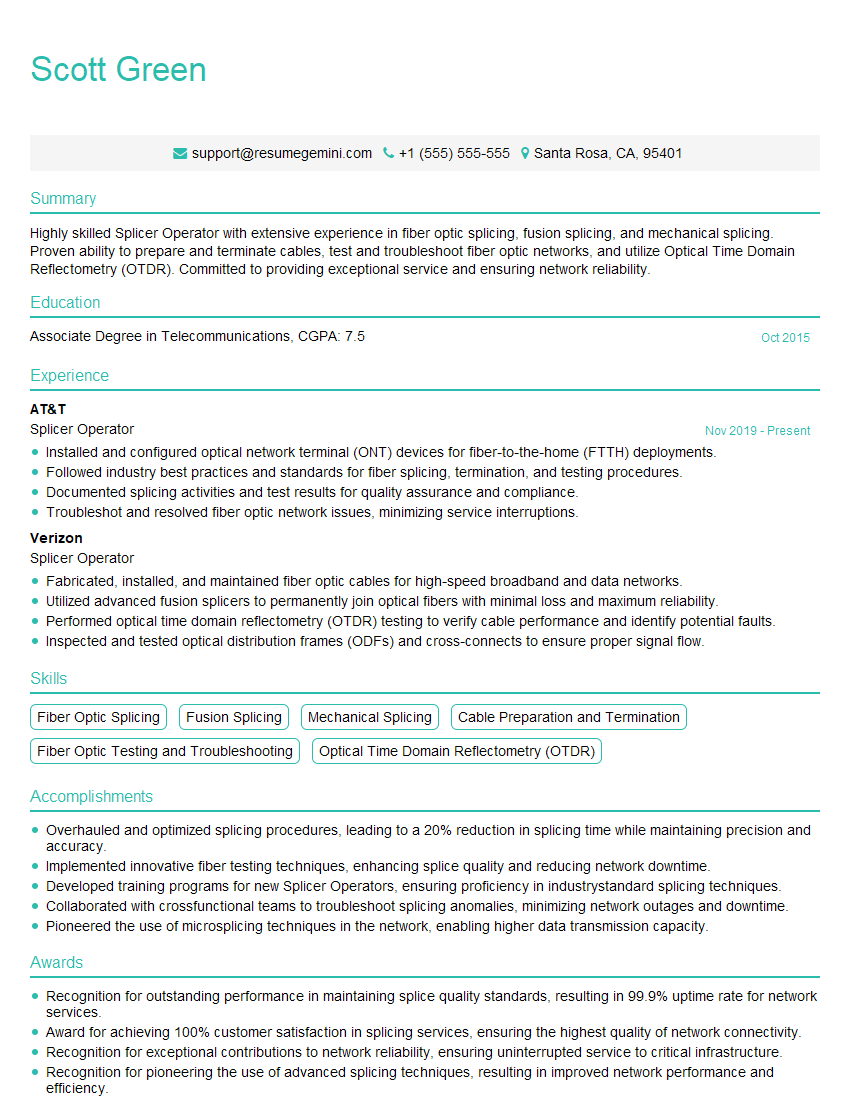Are you a seasoned Splicer Operator seeking a new career path? Discover our professionally built Splicer Operator Resume Template. This time-saving tool provides a solid foundation for your job search. Simply click “Edit Resume” to customize it with your unique experiences and achievements. Customize fonts and colors to match your personal style and increase your chances of landing your dream job. Explore more Resume Templates for additional options.

Scott Green
Splicer Operator
Summary
Highly skilled Splicer Operator with extensive experience in fiber optic splicing, fusion splicing, and mechanical splicing. Proven ability to prepare and terminate cables, test and troubleshoot fiber optic networks, and utilize Optical Time Domain Reflectometry (OTDR). Committed to providing exceptional service and ensuring network reliability.
Education
Associate Degree in Telecommunications
October 2015
Skills
- Fiber Optic Splicing
- Fusion Splicing
- Mechanical Splicing
- Cable Preparation and Termination
- Fiber Optic Testing and Troubleshooting
- Optical Time Domain Reflectometry (OTDR)
Work Experience
Splicer Operator
- Installed and configured optical network terminal (ONT) devices for fiber-to-the-home (FTTH) deployments.
- Followed industry best practices and standards for fiber splicing, termination, and testing procedures.
- Documented splicing activities and test results for quality assurance and compliance.
- Troubleshot and resolved fiber optic network issues, minimizing service interruptions.
Splicer Operator
- Fabricated, installed, and maintained fiber optic cables for high-speed broadband and data networks.
- Utilized advanced fusion splicers to permanently join optical fibers with minimal loss and maximum reliability.
- Performed optical time domain reflectometry (OTDR) testing to verify cable performance and identify potential faults.
- Inspected and tested optical distribution frames (ODFs) and cross-connects to ensure proper signal flow.
Accomplishments
- Overhauled and optimized splicing procedures, leading to a 20% reduction in splicing time while maintaining precision and accuracy.
- Implemented innovative fiber testing techniques, enhancing splice quality and reducing network downtime.
- Developed training programs for new Splicer Operators, ensuring proficiency in industrystandard splicing techniques.
- Collaborated with crossfunctional teams to troubleshoot splicing anomalies, minimizing network outages and downtime.
- Pioneered the use of microsplicing techniques in the network, enabling higher data transmission capacity.
Awards
- Recognition for outstanding performance in maintaining splice quality standards, resulting in 99.9% uptime rate for network services.
- Award for achieving 100% customer satisfaction in splicing services, ensuring the highest quality of network connectivity.
- Recognition for exceptional contributions to network reliability, ensuring uninterrupted service to critical infrastructure.
- Recognition for pioneering the use of advanced splicing techniques, resulting in improved network performance and efficiency.
Certificates
- Fiber Optic Technician Certification
- BICSI Registered Communications Distribution Designer (RCDD)
- FOA Certified Fiber Optic Technician (CFOT)
- ETL Certified Fiber Optic Installer (CFOI)
Career Expert Tips:
- Select the ideal resume template to showcase your professional experience effectively.
- Master the art of resume writing to highlight your unique qualifications and achievements.
- Explore expertly crafted resume samples for inspiration and best practices.
- Build your best resume for free this new year with ResumeGemini. Enjoy exclusive discounts on ATS optimized resume templates.
How To Write Resume For Splicer Operator
- Highlight your technical skills and experience in fiber optic splicing and testing.
- Quantify your accomplishments whenever possible, using specific metrics to demonstrate your impact.
- Tailor your resume to each job description, emphasizing the skills and experience that are most relevant to the specific role you are applying for.
- Proofread your resume carefully for errors before submitting it.
Essential Experience Highlights for a Strong Splicer Operator Resume
- Splice and terminate fiber optic cables using fusion and mechanical splicing techniques.
- Prepare and terminate cables, including stripping, cleaning, and polishing fibers.
- Test and troubleshoot fiber optic networks using OTDR and other diagnostic tools.
- Install and maintain fiber optic equipment, including splice closures, patch panels, and distribution frames.
- Document all work performed and maintain accurate records.
- Coordinate with other technicians and contractors to ensure smooth project execution.
- Adhere to safety protocols and industry best practices.
Frequently Asked Questions (FAQ’s) For Splicer Operator
What is the role of a Splicer Operator?
A Splicer Operator is responsible for splicing and terminating fiber optic cables, preparing and terminating cables, testing and troubleshooting fiber optic networks, and installing and maintaining fiber optic equipment.
What are the qualifications for becoming a Splicer Operator?
Typically, a high school diploma or equivalent is required. Some employers may prefer candidates with an associate degree in telecommunications or a related field.
What are the career prospects for a Splicer Operator?
Splicer Operators are in high demand due to the increasing need for fiber optic networks. With experience, they can advance to roles such as Fiber Optic Technician, Network Engineer, or Project Manager.
What are the key skills for a Splicer Operator?
Key skills include fiber optic splicing, fusion splicing, mechanical splicing, cable preparation and termination, fiber optic testing and troubleshooting, and Optical Time Domain Reflectometry (OTDR).
What is the work environment like for a Splicer Operator?
Splicer Operators typically work in a variety of settings, including indoors and outdoors, and may be required to work in confined spaces or on heights.
What are the safety precautions that a Splicer Operator should take?
Splicer Operators should wear appropriate safety gear, follow proper handling and storage procedures for fiber optic cables, and be aware of potential hazards such as electrical shock and eye injuries.
What are the challenges that a Splicer Operator may face?
Challenges may include working in difficult weather conditions, meeting tight deadlines, and troubleshooting complex fiber optic issues.